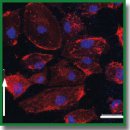
Effectiveness of Using Endothelial Colony-Forming Cells for Creating Tissue-Engineered Vascular Grafts under in vitro Conditions
The aim of the investigation was to assess the effectiveness of using endothelial colony-forming cells (ECFCs) for populating polymer vascular grafts under the conditions of a pulsatile bioreactor.
Materials and Methods. Grafts were fabricated by electrospinning from mixture of poly(3-hydroxybutyrate-co-3-hydroxyvalerate), poly(ε-caprolactone), and type I collagen. To carry out the experiments, a commercial culture of the primary human coronary artery endothelial cells (HCAEC), a culture of the human umbilical vein endothelial cells (HUVEC), and ECFCs obtained from the peripheral blood of patients with IHD have been used. A suspension of the cells at a concentration of 700,000 per ml was introduced into the grafts, cultivated for 2 days under static conditions, then in the pulsatile reactor at shear stress of 1.27 dyn/cm2 for 1 day, and at 2.85 dyn/cm2 for another 5 days. The graft luminal surface underwent immunofluorescent staining for detecting CD31, VEGFR-2, CD144, vWF, F-actin markers and type IV collagen, after that, cell density was also calculated on 1 mm2 of the graft surface.
Results. Changes signifying their adaptation to shear stress have been registered in all cell cultures during culturing under dynamic conditions. They manifested themselves in intensified expression of the specific markers (VEGFR-2), increased secretory activity with regard to vWF and type IV collagen, ordered F-actin filaments and orientation of the cells along the flow, stimulation of intercellular junction formation. However, inevitably, the cells were partially washed off from the graft surface. The analysis of cellular layer density after dynamic cultivation allowed us to conclude that ECFCs had the strongest adhesion to the polymer and resistance to washing away with a flow.
Conclusion. ECFCs may be recognized to be the most promising culture for populating tissue-engineered vascular grafts owing to the possibility of being isolated from a readily available source (peripheral blood) and demonstrated good adaptation to the conditions of dynamic cultivation. However, significant reduction of cellular layer density caused by shear stress speaks of insufficient adhesion of the cells to the surface and requires further investigations to optimize a feeder layer covering the surface of a polymer scaffold.
- Benrashid E., McCoy C.C., Youngwirth L.M., Kim J., Manson R.J., Otto J.C., Lawson J.H. Tissue engineered vascular grafts: origins, development, and current strategies for clinical application. Methods 2016; 99: 13–19, https://doi.org/10.1016/j.ymeth.2015.07.014.
- Drews J.D., Miyachi H., Shinoka T. Tissue-engineered vascular grafts for congenital cardiac disease: clinical experience and current status. Trends Cardiovasc Med 2017; 27(8): 521–531, https://doi.org/10.1016/j.tcm.2017.06.013.
- Melchiorri A.J., Hibino N., Fisher J.P. Strategies and techniques to enhance the in situ endothelialization of small-diameter biodegradable polymeric vascular grafts. Tissue Eng Part B Rev 2013; 19(4): 292–307, https://doi.org/10.1089/ten.teb.2012.0577.
- Hoch E., Tovar G.E., Borchers K. Bioprinting of artificial blood vessels: current approaches towards a demanding goal. Eur J Cardiothorac Surg 2014; 46(5): 767–778, https://doi.org/10.1093/ejcts/ezu242.
- Wang X., Lin P., Yao Q., Chen C. Development of small-diameter vascular grafts. World J Surg 2007; 31(4): 682–689, https://doi.org/10.1007/s00268-006-0731-z.
- Hauser S., Jung F., Pietzsch J. Human endothelial cell models in biomaterial research. Trends Biotechnol 2017; 35(3): 265–277, https://doi.org/10.1016/j.tibtech.2016.09.007.
- Couet F., Meghezi S., Mantovani D. Fetal development, mechanobiology and optimal control processes can improve vascular tissue regeneration in bioreactors: an integrative review. Med Eng Phys 2012; 34(3): 269–278, https://doi.org/10.1016/j.medengphy.2011.10.009.
- van Haaften E.E., Bouten C.V.C., Kurniawan N.A. Vascular mechanobiology: towards control of in situ regeneration. Cells 2017; 6(3): E19, https://doi.org/10.3390/cells6030019.
- Kirton J.P., Xu Q. Endothelial precursors in vascular repair. Microvasc Res 2010; 79(3): 193–199, https://doi.org/10.1016/j.mvr.2010.02.009.
- Lee P.S., Poh K.K. Endothelial progenitor cells in cardiovascular diseases. World J Stem Cells 2014; 6(3): 355–366, https://doi.org/10.4252/wjsc.v6.i3.355.
- Jaffe E.A., Nachman R.L., Becker C.G., Minick C.R. Culture of human endothelial cells derived from umbilical veins. Identification by morphologic and immunologic criteria. J Clin Invest 1973; 52(11): 2745–2756, https://doi.org/10.1172/jci107470.
- Kolbe M., Dohle E., Katerla D., Kirkpatrick C.J., Fuchs S. Enrichment of outgrowth endothelial cells in high and low colony-forming cultures from peripheral blood progenitors. Tissue Eng Part C Methods 2010; 16(5): 877–886, https://doi.org/10.1089/ten.tec.2009.0492.
- Tzima E., Irani-Tehrani M., Kiosses W.B., Dejana E., Schultz D.A., Engelhardt B., Cao G., DeLisser H., Schwartz M.A. A mechanosensory complex that mediates the endothelial cell response to fluid shear stress. Nature 2005; 437(7057): 426–431, https://doi.org/10.1038/nature03952.
- Nayak L., Lin Z., Jain M.K. “Go with the flow”: how Krüppel-like factor 2 regulates the vasoprotective effects of shear stress. Antioxid Redox Signal 2011; 15(5): 1449–1461, https://doi.org/10.1089/ars.2010.3647.
- Fisher A.B., Chien S., Barakat A.I., Nerem R.M. Endothelial cellular response to altered shear stress. Am J Physiol Lung Cell Mol Physiol 2001; 281(3): L529–L533, https://doi.org/10.1152/ajplung.2001.281.3.l529.
- Liu H., Gong X., Jing X., Ding X., Yao Y., Huang Y., Fan Y. Shear stress with appropriate time-step and amplification enhances endothelial cell retention on vascular grafts. J Tissue Eng Regen Med 2017; 11(11): 2965–2978, https://doi.org/10.1002/term.2196.
- Tondreau M.Y., Laterreur V., Gauvin R., Vallières K., Bourget J.M., Lacroix D., Tremblay C., Germain L., Ruel J., Auger F.A. Mechanical properties of endothelialized fibroblast-derived vascular scaffolds stimulated in a bioreactor. Acta Biomater 2015; 18: 176–185, https://doi.org/10.1016/j.actbio.2015.02.026.
- Wang X., Cooper S. Adhesion of endothelial cells and endothelial progenitor cells on peptide-linked polymers in shear flow. Tissue Eng Part A 2013; 19(9–10): 1113–1121, https://doi.org/10.1089/ten.tea.2011.0653.
- dela Paz N.G., Walshe T.E., Leach L.L., Saint-Geniez M., D’Amore P.A. Role of shear-stress-induced VEGF expression in endothelial cell survival. J Cell Sci 2012; 125(4): 831–843, https://doi.org/10.1242/jcs.084301.
- Gogia S., Neelamegham S. Role of fluid shear stress in regulating VWF structure, function and related blood disorders. Biorheology 2015; 52(5–6): 319–335, https://doi.org/10.3233/bir-15061.
- Matveeva V.G., Khanova M.Yu., Velikanova E.A., Antonova L.V., Sardin E.S., Krutitsky S.S., Barbarash O.L. Isolation and characteristics of colony-forming endothelial cells from peripheral blood in patients with ischemic heart disease. Tsitologiia 2018; 60(8): 598–608.










